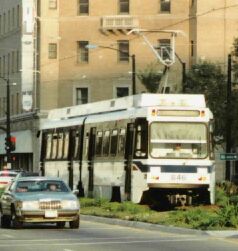
Light Rail Now/Light Rail Progress can be contacted at: Light Rail Now! |
California's Santa Clara Valley Transportation Authority (VTA) currently
operates a 30.5-mile, multi-route light rail transit (LRT) system
extending from south San Jose through downtown to the northern areas of San Jose, Santa Clara, Mountain View, and Sunnyvale.
Service has been operating 24 hours, every 15 minutes during
much of the day, and the system carries about 22,500 riders on an average weekday. There are 45 convenient stops along the system, including
residential areas of South San Jose, Downtown San Jose, San Jose Civic Center, North First Street high-tech area, Paramount's
Great America theme park, Tasman Drive high-tech and residential areas, Lockheed Martin, Middlefield Road industrial
areas, and Downtown Mountain View. Schedule speed, end-to-end from Santa Teresa to Baypointe, is, for a system routed mainly in street and highway right-of-way, fairly high at
approximately 20 mph – and that includes the slow-running segment through San Jose's CBD, with a maximum speed of 10 mph. Schedule speed for the southern segment, from
Santa Teresa to the CBD, is even higher, at about 24 mph. The first segment of the original starter LRT system opened in 1987, and the entire starter system was completed in 1991. The system basically consists of 3 lines: · Baypoint-Santa Teresa These are shown on the map below.
The LRT system has been increasingly cost-effective in its
operations. The most recent Federal Transit Administration (FTA)
data currently available, for 2001, indicate that VTA's LRT operating and maintenance costs were $0.86 per passenger-mile
vs. $1.07 for VTA buses. Per rider-trip, they were $3.97 for LRT vs. $4.11 for bus.
One of VTA's Strategic Plan goals has been to integrate
transportation and land use planning. To accomplish this goal,
VTA's Transit-Oriented Development Program was established.
This program strives to intensify and diversify land uses and
enhance pedestrian circulation at appropriate locations. VTA's
LRT has been increasingly successful in attracting transit-oriented
development (TOD), with the potential to build future ridership.
For example, a residential project in Mountain View has been
developed in the Whisman Station area along the Tasman West Line as a result of the TOD effort. California's budget crisis and the huge nationwide slump in economic activity, which has particularly hit all of Silicon Valley, destroying jobs and reducing travel, has been decimating virtually all transit ridership, and VTA's services are no exception. A severe drop in both bus and LRT ridership has prompted VTA to pursue service cutbacks, fare increases, and the postponement of some planned expansion projects. Photo credits: L. Henry (modern LRT scenes and streetcar). VTA (map). Updated 2003/06/03 |